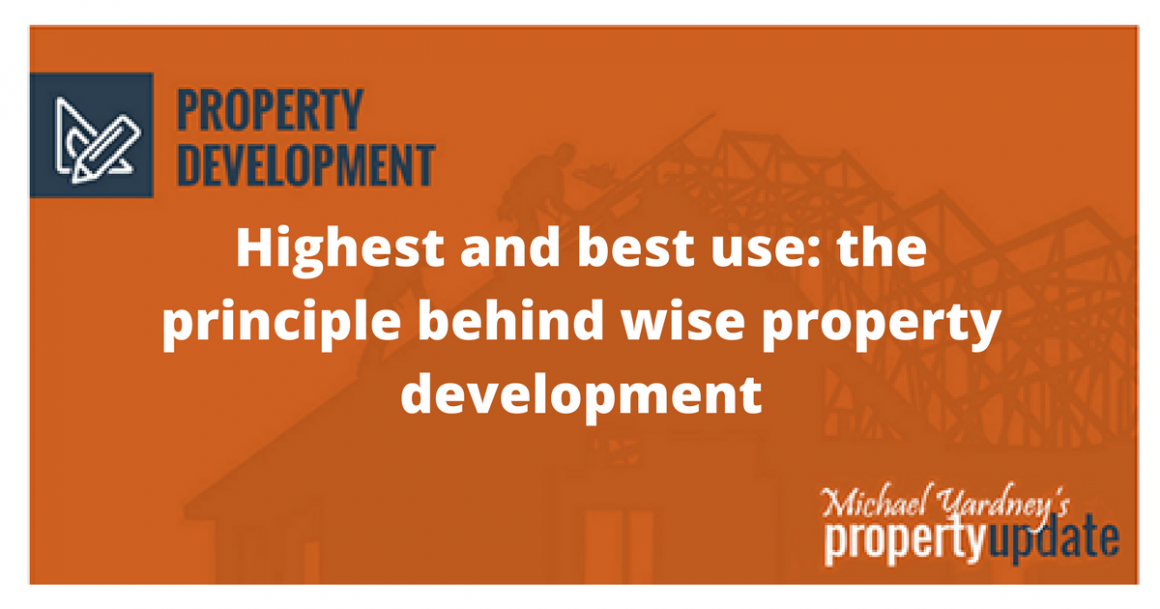If you’re interested in getting involved in property development, or even if you’re keen to do serious renovations, there is an important principle you must understand.
It’s the basis of all feasibility studies and it’s called highest and best use. 
Just like smart businesses try and maximise the return on their assets, so should you as a property investor.
And overlooking this principle means you won’t maximise the value of your development and get the highest return on your money.
So when I look at a potential development site I always ask myself “what is this property’s highest and best use?” because this will determine what that particular property is worth to me.
In order to determine the highest and best use of a property, any potential development proposal (or major renovation proposal) must pass series of four tests.
1. Is the proposed development physically possible?
Any potential use must be physically possible given the size, shape, topography, and other characteristics of the site. 
For example, you’re not going to be able to build an apartment building on a standard suburban block.
Now this has nothing to do with the zoning (I’ll explain that in a moment).
Most of the time it boils down to engineering – the cost of constructing a 2-level basement on a site with poor sub-soil conditions may not be the best use.
2. Is the proposed development legally allowable?
Obviously, the proposed new use of the property has to be legally allowable.
The first hurdle is local government zoning.
All councils have areas:
where they encourage larger scale development (usually around main roads and transport hubs),
areas where they discourage development such as heritage zones and
areas where they allow incremental development.
So while a particular plot of land may be large enough to accommodate three townhouses, the local government zoning (when taking into account setbacks, garden zones and car parking and dri veways) may only allow a duplex development.
veways) may only allow a duplex development.
Then, certain uses may be forbidden by government regulations or prohibited by title restrictions or covenants.
You will find that most potential development sites advertised as “STCA” (subject to council approval) which really means that any representation made by the selling agent is useless and you’ll have to undertake your own due diligence.
This is a little easier in Victoria where the seller must provide potential purchasers with a vendors statement, but in other states the responsibility rests on the purchaser to conduct their own due diligence.
At my upcoming 2 day Property Renovations and Development Workshop we’ll be going into quite some detail about how to find a site with development potential, including how and where we do our research.
It on October 26th and 27th so if you’re keen to take your investing to the next level and get involved in property renovations or development, you can click here to get all the details on this special training event.
Or why not contact Jo Fitt [email protected] or call her on 03 9591 8888 and find out if this workshop would be suitable for you?
3. Will the proposed project be financially feasible?
At Metropole we conduct substantial feasibility studies on any proposed development site we investigate.
Obviously, the proposed development must deliver a sufficient profit for the developer to justify the costs of construction, and to cover the risks related to the development.
This is where I see many beginning investors make mistakes: 
they don’t know which numbers to plug into the feasibility and therefore have unrealistic expectations
they don’t allow themselves enough profit margin for the risks involved in the project
they don’t allow contingency – they’re always time and cost overruns, or
they are so keen to get involved in property development they don’t allow themselves a reasonable profit margin and can’t get finance, as recently lenders have tightened construction lending.
At my Property Renovations and Development Workshop we explain in detail how we conduct our feasibility studies – you’ll see real examples, because we know how much they can help.
It on October 26th and 27th so if you’re keen to take your investing to the next level and get involved in property renovations or development, you can click here to get all the details on this special training event.
Or why not contact Jo Fitt [email protected] or call her on 03 9591 8888 and find out if this workshop would be suitable for you?
4. Will the property achieve maximum productivity?
The maximal productivity of a property is tightly related to its ability to generate the highest net return to the developer.
In a recent feasibility study we were involved in, a large block of land could have been developed into eight small apartments or, alternatively, three luxury townhouses. 
Interestingly the highest and best use (the project which delivered the maximum profit for the minimum risk) was the three townhouse development.
This in part had to do with the local demographics, where there was strong demand and limited supply of luxury townhouses due to downsizing baby boomers.
Highest return can mean different thing to different people – Internal Rate of Return, Net Present Value, development profit or residual land value.
In my opinion, the use that generates the highest net present value is the highest and best use, because it takes into account both the time value of money and the cost of capital.
The bottom line:
As our cities mature and the way we live changes there will be an increasing need for densification, and the highest and best use for a property tomorrow in a decade is unlikely to be the same as its higher and best use today. 
The challenge for potential property developers is to understand what type of property will be in continuous strong demand in the future and deliver that to the market.
These always make great investment grade properties to hold onto in the long-term.
Of course, at my upcoming 2 day Property Renovations and Development Workshop we go into far more detail about these four tests, and teach investors like you how to step up to the big leagues of property development.
Click here to get all the details and reserve your spot – but hurry, seats are limited and it’s on on October 26th and 27th!
Or why not contact Jo Fitt [email protected] or call her on 03 9591 8888 and find out if this workshop would be suitable for you?
You’re covered by my personal money back guarantee.
Read more: propertyupdate.com.au


